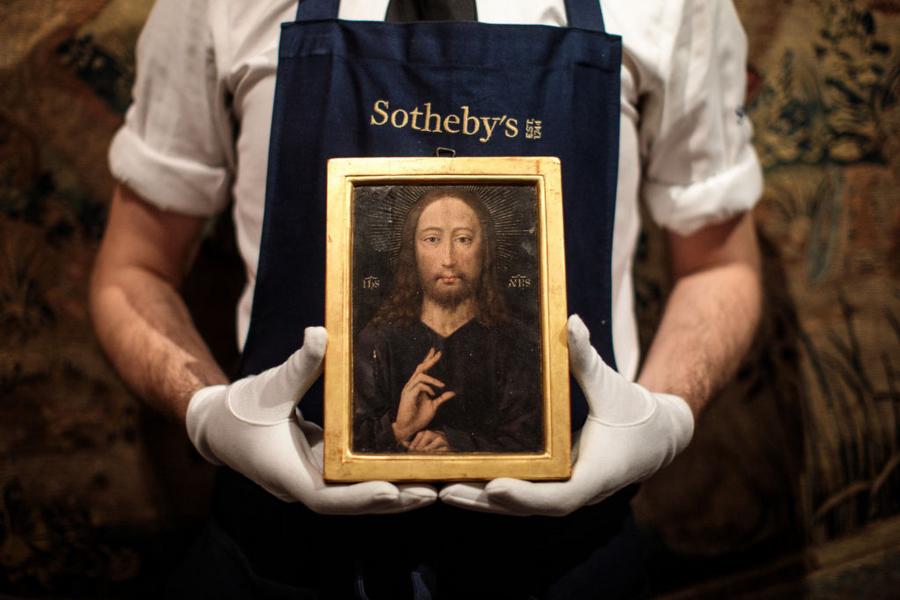You might recall the controversy surrounding Salvator Mundi, the so-called "last da Vinci" painting that resurfaced in 2005 and sold for just $10,000 at an estate sale before it was attributed to legendary artist Leonardo da Vinci, after which it became the most expensive painting in the world, selling for a little over $450 million in 2017. Since then, the painting has been mired in controversy, with many suggesting that the "revelation" that it was in fact painted by da Vinci (as opposed to one of his pupils) doesn't hold water. Now, in an essay for ArtWatch UK, art expert Jacques Franck is casting new doubts on the painting's true origins.
Franck isn't using science or history to disprove the notion that Salvator Mundi was painted by da Vinci. Instead he's using his expertise on da Vinci's actual work, and claiming that the painting simply does not meet the master's standards:
"When the index and the middle finger are raised fully, one cannot bend the other fingers inside the palm extensively as observed in the Salvator Mundi's blessing hand. It is therefore an unlikely movement."

Jack Taylor/Getty Images
That goes against da Vinci's documented mastery and attention to detail of human anatomy, Franck says. And that's not the only feature of the painting he takes issue with, also pointing out "the oddly long and thin nose, the mechanical hair ringlets, the flat orb and the over-shadowy neck" of its subject.
ArtWatch UK Director Michael Daley seems to agree:
"Nobody was as anatomically sophisticated as Leonardo. The problems with the hands, which can't have been painted by Leonardo are just one of the great untalked about things of this painting… When you discover one thing that is wrong with a painting it tends to be that you discover everything is wrong with a painting."
A layman might assume that the painting could have simply been created on an off-day for Leonardo, but some scholars of the master's work are adamant that he didn't have any off-days. Instead, Franck says that artists Salai and Baltraffio, contemporaries of da Vinci's who worked under him, might have painted the piece, which was painted sometime around 1500 (the painting was originally attributed to Baltraffio before the "discovery" that it was supposedly the work of da Vinci was made).
We may never know for sure whether Leonardo da Vinci painted Salvator Mundi with his own hands, and Franck is just one scholar among many who are debating that point, and the painting is shrouded in other mysteries as well, such as who exactly purchased it in 2017 (allegedly Saudi crown prince Mohammed bin Salman) and where it's located now.
/2018/11/GettyImages-874564988.jpg)
/2021/11/Salvator-Mundi.jpg)
/2017/10/GettyImages-860814634.jpg)
/2017/12/GettyImages-874565026.jpg)
/2021/04/GettyImages-1177560743.jpg)
/2021/03/chris.jpg)
/2022/01/mary-lou.jpg)
/2013/07/GettyImages-800836002.jpg)
/2015/03/GettyImages-98102880.jpg)
:strip_exif()/2020/06/taylor.png)
/2020/04/Eddie-Vedder.jpg)
/2011/07/Drake-Bell-1.jpg)
/2021/05/gary.jpg)
/2012/12/Brooke-Mueller.jpg)
/2013/07/GettyImages-504405760.jpg)
/2022/11/charlie-sheen.jpg)
/2025/03/sami.png)
/2014/08/GettyImages-458847397.jpg)
/2009/12/Denise-Richards.jpg)
/2013/09/Sean-Duffy.jpg)
/2021/03/Morgan-Wallen2.jpg)
/2020/02/kim-richards-1.jpg)
/2016/01/Kirk-Cousins.jpg)